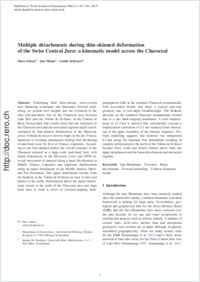Multiple detachments during thin-skinned deformation of the Swiss Central Jura: a kinematic model across the Chasseral
- Schori, Marc Department of Geosciences, Université de Fribourg, Switzerland
- Mosar, Jon Department of Geosciences, Université de Fribourg, Switzerland
- Schreurs, Guido Institut für Geologie, Universität Bern, Switzerland
-
09.09.2015
Published in:
- Swiss Journal of Geosciences. - 2015, vol. 108, no. 2-3, p. 327–343
English
Combining field observations, cross-section area balancing techniques and kinematic forward modelling, we present new insights into the evolution of the Jura fold-and-thrust belt in the Chasseral area between Lake Biel and the Vallon de St-Imier, in the Canton of Bern, Switzerland. Our results show that the structures of the Chasseral area and the associated regional uplift can be explained by thin-skinned deformation of the Mesozoic cover, without the need to involve highs in the pre-Triassic basement or invoking detachment folding with thickening of anticlinal cores by flow of Triassic evaporites. According to our thin-skinned model, the overall structure of the Chasseral initiated as a large-scale fault-bend fold, with initial detachment of the Mesozoic cover and NNW-directed movement of material along a basal décollement in Middle Triassic evaporites and important displacement along an upper detachment in the Middle Jurassic Opalinus-Ton Formation. This upper detachment extends from the Seekette to the Vallon de St-Imier (at least 11 km) and further to the north. Deformation above the upper detachment occurs to the north of the Chasseral area and steps back later to form a series of forward-stepping fault-propagation folds at the northern Chasseral mountainside, with associated thrusts that show a typical stair-step geometry due to low-angle breakthroughs. The Seekette anticline on the southern Chasseral mountainside formed due to a late back-stepping backthrust. A total displacement of 11.3 km is inferred that considerably exceeds a displacement estimation of 5.1 km deduced from shortening of the upper boundary of the Jurassic sequence. Forward modelling suggests that material was transported 6.2 km along the Opalinus-Ton detachment resulting in complex deformation to the north of the Vallon de St-Imier because there, folds and thrusts formed above both, the upper detachment and the basal décollement and interacted together.
- Faculty
- Faculté des sciences et de médecine
- Department
- Département de Géosciences
- Language
-
- English
- Classification
- Geology
- License
- License undefined
- Identifiers
-
- RERO DOC 258348
- DOI 10.1007/s00015-015-0196-x
- Persistent URL
- https://folia.unifr.ch/unifr/documents/304770
Other files
Statistics
Document views: 84
File downloads:
- mos_mdd.pdf: 304
- mos_mdd_sm.pdf: 120

